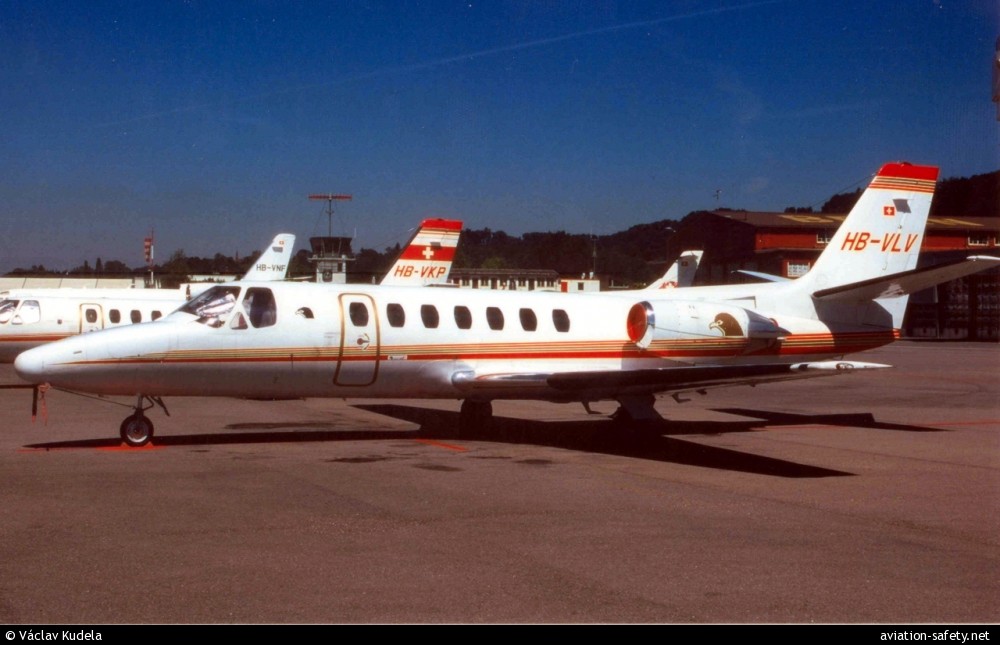
| Date: | Thursday 20 December 2001 |
| Time: | 22:07 |
| Type: |  Cessna 560 Citation V |
| Owner/operator: | Eagle Air Ltd. Aircharter + Taxi |
| Registration: | HB-VLV |
| MSN: | 560-0077 |
| Year of manufacture: | 1990 |
| Total airframe hrs: | 3559 hours |
| Cycles: | 3528 flights |
| Engine model: | Pratt & Whitney Canada JT15D-5A |
| Fatalities: | Fatalities: 2 / Occupants: 2 |
| Aircraft damage: | Destroyed, written off |
| Category: | Accident |
| Location: | Zürich-Kloten Airport (ZRH) -
 Switzerland Switzerland
|
| Phase: | Initial climb |
| Nature: | Ferry/positioning |
| Departure airport: | Zürich-Kloten Airport (ZRH/LSZH) |
| Berne-Belp Airport (BRN/LSZB) | |
| Investigating agency: | BFU Switz. |
| Confidence Rating: |
Cessna Citation HB-VLV arrived at Zürich at 20:31 following a charter flight from East Midlands. The airplane was scheduled to be ferried to Bern the same evening. Takeoff was postponed due to deteriorating weather circumstances. This meant additional pressure on the crew since they had to arrive at Bern before 22:30 for which the company CEO had received a special authorisation. Finally at 21:43 the crew were cleared to start the engines. The aircraft then taxied to runway 34 for departure. The crew taxied onto the runway and, after they had received takeoff clearance at 22:05:54, initiated a rolling takeoff by setting takeoff power. At this time, meteorological visibility was 100 m with partial fog. After reaching a height of 500 to 600 ft above ground level, the aircraft began to loose altitude. A corrective manoeuvre was commenced though this was not able to prevent impact with the ground. The aircraft impacted onto the frozen ground 400 m to the south-east of the end of runway 34 and skidded in a northerly direction, leaving a trail of debris.
CAUSES:
The accident is attributable to the fact that the crew of HB-VLV did not continue their climb after take-off. As a result the aircraft came in a descent and collided with the terrain. The investigation determined the following causal factor for the accident:
- With a high degree of probability the crew lost spatial orientation after take-off, leading to an unintentional loss of altitude.
The following factors contributed to the accident:
- The copilots basic training in instrument flying did not include night instrument take-offs.
- The crews method of working was adversely affected by great time pressure.
- Executing the take-off as a rolling take-off was not adapted to the prevailing meteorological conditions.
- There was no system in the aircraft which triggers an alarm in the event of a loss of altitude after take-off (GPWS).
- The instrumentation on the copilots side of the aircraft involved in the accident was not optimal.
Accident investigation:
 |
|
Sources:
Location
Images:

photo (c) Václav Kudela; Berne-Belp Airport (BRN); August 2001
Revision history:
| Date/time | Contributor | Updates |
|---|
The Aviation Safety Network is an exclusive service provided by:


 ©2024 Flight Safety Foundation
©2024 Flight Safety Foundation